Curing The Primary Care Shortage

There is one undisputable fact all sides of the debate about the Affordable Care Act (ACA) agree upon: There is a shortage of primary care physicians currently and adding over 30 million more people to the insurance roles will only exacerbate the problem.
There are many factors behind a few shortages, but a few stand out:
1. The federal cap on the number of doctors whose training it will pay for
2. The distinct earnings gap between specialists and primary care physicians
3. The sense in the medical community that being a primary care physician is less important
A few years ago, the shortage was primarily only noticeable in rural areas, where the earnings gap was even greater.
To address this issue, rural communities started banding together to offer extra incentives to entice and keep their local doctor in the community. States like Missouri created innovative and successful tracking programs that identified potential physicians who were from rural areas in undergraduate school and worked closely with them as they moved through their training to keep them close to their local roots.
But now the problem has moved into regions no one would expect would have physician shortages. A recent New Jersey report recently noted a shortage of primary care physicians (about 1,000 less than needed), but also a specialist shortage of about 1,800.
Nationally, the primary care physician shortage currently stands at about 15,000. In just 15 years it is projected that will eventually grow to 130,000.
The shortage is not just irksome for patients who may have to wait months to see their doctor – it’s potentially life threatening, financially counterproductive, and it has a major impact on other parts of the health care system, specifically emergency care.
How do we address this significant problem?
First, both political parties in Washington must join together and increase the primary care training budget significantly.
In California, we must ensure that our medical schools are both expanded and properly funded. We must create more community-based mentoring and tracking programs like the pipeline training and tracking program created by UC Riverside.
The pay gap between primary and specialty physicians must be narrowed. Doctors go into the profession to help people and most have an enviable altruistic streak. However, they have mortgages and school bills and insurance payments just like everyone else. They will gravitate toward fields where they can be better ensured of making sure they have enough money.
We should increase on-going primary physician training to allow them, their nurses, and their support staff to better care for and diagnose issues in a way that will lessen the need for specialists. Not only would this address the internal social issues noted above, it would also entice more people to choose the primary care route over the specialist route. Training programs for physician assistants and nurse practioners should be significantly increased as they can handle and address many primary care issues.
We also need to increase funding and development of electronic medical records, diagnostic tools, and email technologies to improve the overall case delivery.
Finally, the use of clinics and other retail establishment that provide efficient and effective care delivery should be enhanced.
We must address this issue in a serious, collaborative manner immediately. It takes up to 10 years to fully train a physician – if we don’t start now it may be too late.
Henry Loubet is the chief strategy officer for Keenan, one of the nation’s largest independent health insurance brokers. He sits on the Payers & Providers editorial board.






